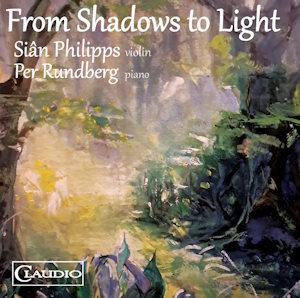
From Shadows to Light
John Hawkins (b.1949)
Looking Back (2014)
Grace Williams (1906-1977)
Violin Sonata (1930)
Paul Ladmirault (1877-1944)
De l’Ombre à la Clarté-Fantaisie Modale (1938)
Ralph Vaughan Williams (1872-1958)
The Lark Ascending (1914)
Romance (1914 rev 1923)
Egon Wellesz (1885-1974)
Sonata for solo violin, Op.72 (1953-59)
Sally Beamish (b.1956)
Praeludium and Allegro (2018)
Siân Philipps (violin)
Per Rundberg (piano)
rec. no date, Yehudi Menuhin School, St Bartholomews, Henry Wood Hall, UK
Claudio CC6035-2 [61]
This is an attractive recital made at three different locations on unspecified dates that covers over a century of music for violin and piano. Two of the pieces are from recent years – the works of John Hawkins, written for Siân Philipps, and Sally Beamish, whilst the earliest are by Vaughan Williams. Those three different locations aren’t troublesome to me though the change in acoustic is very noticeable.
John Hawkins’ Looking Back is an Orphean piece inspired by the backward glance of the mythical character, its pungent lyricism irradiating the music to fine effect: an admirable, concise work. Sally Beamish’s Praeludium and Allegro clearly alludes to Kreisler’s piece of the same name and was commissioned by the Carl Nielsen International Competition. It’s full of quietly witty intervals and demands some bowing maturity whilst the crisply tricky writing on dapper themes requires command of both left and right hand – and an alert mind as well.
Grace Williams wrote her Violin Sonata in 1930 and it reflects the range of influences on her at the time. One is Bartók, audible in the opening movement in its terse and occasionally truculent assertiveness, whilst in the central movement the rich piano chording supporting bardic folkloric writing hints strongly at Vaughan Williams. The violin’s soaring, yearning quality is most attractive. The finale’s vivacious barbaro qualities – Bartókian again – are exciting and indeed excitingly played by the Philipps-Rundberg duo. They’re certainly quite a bit quicker than Madeleine Mitchell and Konstantin Lapshin on Naxos.
The music of Paul Ladmirault crops up pretty rarely but his De l’Ombre à la Clarté-Fantaisie Modale is a charmer. Composed in 1938 it’s suffused in subtle but direct lyricism. Debussy said of the young composer that his music was ‘afraid of expressing itself too much’ but that’s not the impression left by the much older composer writing toward the end of his life. Elements of this piece even evoke a more clement vision of a Romanian Dance, by – of course – Bartók. Elsewhere, though, the ethos is of Breton folklore, and parallels with his contemporary Vaughan Williams are not too far away. It’s only a very brief piece but even at nine minutes, it maintains interest and a certain playful, honest delight.
Talking of VW brings us to The Lark Ascending, heard here in its original guise and played very adroitly by both musicians. For one thing, it’s well shaped and it’s not etiolated – there’s nothing over-lingering. Double stops are crisp and tight, and the performance a good one. The Romance is an attractive piece dating from the same time.
Egon Wellesz wrote his solo Sonata between 1953-59. Cast in four movements it lasts just over eight minutes and is a cryptic example of Wellesz’s style – variously terse and angular, ambivalent and reserved, but energetic. He makes use of pizzicati in the finale more than anywhere else to heighten the music’s drama. A touch wintry, if I’m honest, but splendidly laid out for the performer.
The booklet notes are compact and to the point, written by Philipps herself.
She performs splendidly here whether in proselytising for new music or discovering older, more neglected scores. She’s aided in no small measure by Rundberg. If you can overlook those shifts in acoustic, you will be well rewarded.
Jonathan Woolf
Buying this recording via a link below generates revenue for MWI, which helps the site remain free



















